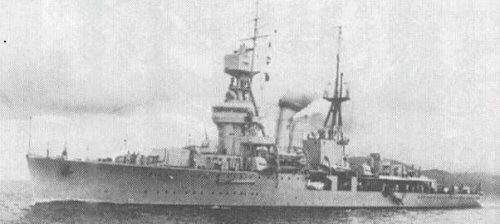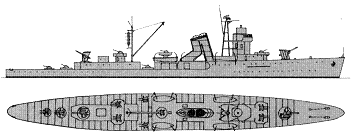
NAVYPEDIA
 Support the project with paypal
Support the project with paypal
Photo

Ioshima
Ships
| Name | No | Yard No | Builder | Laid down | Launched | Comp | Fate |
|---|---|---|---|---|---|---|---|
| 五百島 [Ioshima] (ex-甯海 [Ning Hai]) | Harima Co, Harima | 20.2.1931 | 10.10.1931 | 31.7.1932 // 28.6.1944 | sunk 19.9.1944 | ||
| 八十島 [Yasoshima] (ex-平海 [Ping Hai]) | Kiangnan, Shanghai, China | 28.6.1931 | 28.9.1935 | 18.6.1936 // 10.6.1944 | sunk 25.11.1944 |
Technical data
| Displacement standard, t | 2165 |
|---|---|
| Displacement full, t | 2500 |
| Length, m | 106.7 pp 109.7 oa |
| Breadth, m | 11.9 |
| Draught, m | 3.96 |
| No of shafts | Yasoshima: 2 Ioshima: 3 |
| Machinery | Yasoshima: 2 VTE, 4 Kampon boilers Ioshima: 3 VTE, 2 Kampon boilers |
| Power, h. p. | 9000 |
| Max speed, kts | 22.2 |
| Fuel, t | coal 600 + oil 110 |
| Endurance, nm(kts) | 5000(12) |
| Armour, mm | belt: 25, deck: 19 |
| Armament | 2 x 1 - 120/45 10-shiki, 5 x 3 - 25/60 96-shiki, 2 DCR (18) |
| Electronic equipment | 2-shiki 2-go radar, 93-shiki sonar |
| Complement | 340 |
Standard scale images

Yasoshima 1944
Graphics
Project history
Former Chinese cruisers (actually big gunboats or sloops) Ming Hai and Ping Hai. The design of these ships was developed by request of Chinese government in Japan. Here also lead Ning Hai was built. Building of Ping Hai was conducted in China with technical assistance of Japan, however after a deterioration of relations between these countries in 1933 "island neighbour" has ceased to render the technical help and it was possible to finish building ship only after attraction of German experts, thus the design has been significantly modified. Formally sister ships had a number of basic differences: for example Ning Hai had three shafts and Ping Hai had two.
During full-scale war which have burst in 1937 between Japan and China both cruisers have quickly enough felt to Japanese hands. 23.9.1937 Ping Hai has been damaged by Japanese aircraft and sunk on shallow water on Yangtze river. Ning Hai, also damaged by Japanese aircraft, 25.9.1937 was partially scuttled on shoal on Yangtze. Late year both ships were captured by occurring Japanese army, and 5.12.1937 they have been enlisted into IJN. In 1938 ships were salvaged and after temporary repair laid up. Only in 1943 "Chineses" have recollected: decision to arrange them as escort flagships was accepted. Thus their armament were completely changed, boilers were converted to oil-firing (on Ning Hai) or replaced by new (Ping Hai). On Ning Hai works have begun in December, 1943, and on Ping Hai in January, 1944.
On June, 1st, 1944, shortly before commission, ships have renamed: loshima (ex-Ning Hai) and Yasoshima (ex-Ping Hai). Original armament consisted of 3x2 140mm/50 guns, 76mm or 88mm AA guns and 2 twin 533mm TTs. As escorts loshima and Yasoshima carried two DP 120mm/45 guns and 5 triple 25mm MGs. ASW armament included 2 DCT and 2 DCR. On September, 25th, 1944 Yasoshima was reclassified from escort to 2nd class cruiser.
Ship protection
Main belt and main deck protected only machinery and consisted of construction steel.
Modernizations
8.1944, Yasoshima: + 4 x 2 - 25/60 96-shiki, 12 x 1 - 25/60 96-shiki, 8 x 1 - 13.2/76
Naval service
loshima 19.9.1944 was sunk S off Honshu by US submarine Shad. Yasoshima 25.11.1944 was sunk by US carrier aircraft at Luzon coast.
 HOME
HOME FIGHTING SHIPS OF THE WORLD
FIGHTING SHIPS OF THE WORLD JAPAN
JAPAN CRUISERS
CRUISERS IOSHIMA light cruisers (1932 - 1936 / 1944)
IOSHIMA light cruisers (1932 - 1936 / 1944)
